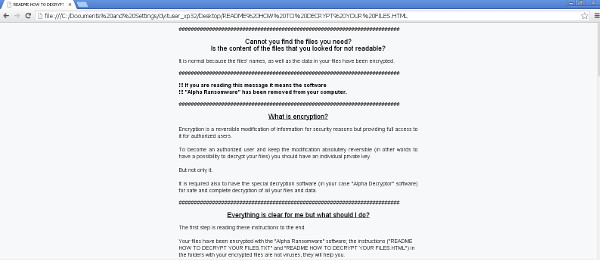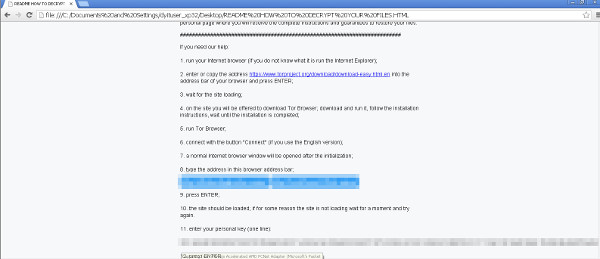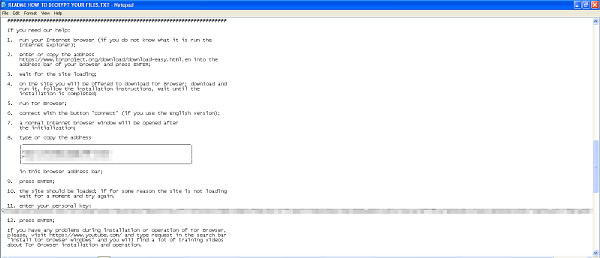RANSOM_ALFA.A
Trojan-Ransom.Win32.Cryalfa.b(Kaspersky)
Windows


Threat Type: Trojan
Destructiveness: No
Encrypted: No
In the wild: Yes
OVERVIEW
Downloaded from the Internet, Dropped by other malware
This Trojan arrives on a system as a file dropped by other malware or as a file downloaded unknowingly by users when visiting malicious sites.
It connects to certain websites to send and receive information.
TECHNICAL DETAILS
192,000 bytes
EXE
No
13 Jul 2016
Encrypts files, Displays message/message boxes, Connects to URLs/IPs
Arrival Details
This Trojan arrives on a system as a file dropped by other malware or as a file downloaded unknowingly by users when visiting malicious sites.
Installation
This Trojan drops a copy of itself in the following folders using different file names:
- %Application Data%\Microsoft\Essential\msestl32.exe
(Note: %Application Data% is the Application Data folder, where it usually is C:\Documents and Settings\{user name}\Application Data on Windows 2000, Windows Server 2003, and Windows XP (32- and 64-bit); C:\Users\{user name}\AppData\Roaming on Windows Vista (32- and 64-bit), Windows 7 (32- and 64-bit), Windows 8 (32- and 64-bit), Windows 8.1 (32- and 64-bit), Windows Server 2008, and Windows Server 2012.)
It drops and executes the following files:
- %Desktop%\README HOW TO DECRYPT YOUR FILES.HTML - serves as ransom note
- %Desktop%\README HOW TO DECRYPT YOUR FILES.TXT - serves as ransom note
(Note: %Desktop% is the desktop folder, where it usually is C:\Documents and Settings\{user name}\Desktop in Windows 2000, Windows Server 2003, and Windows XP (32- and 64-bit); C:\Users\{user name}\Desktop in Windows Vista (32- and 64-bit), Windows 7 (32- and 64-bit), Windows 8 (32- and 64-bit), Windows 8.1 (32- and 64-bit), Windows Server 2008, and Windows Server 2012.)
It adds the following processes:
- explorer.exe
- dllhost.exe
Autostart Technique
This Trojan modifies the following registry entries to ensure it automatic execution at every system startup:
HKEY_CURRENT_USER\Software\Microsoft\
Windows\CurrentVersion\Run
MSEstl = %Application Data%\Microsoft\Essential\msestl32.exe
Other System Modifications
This Trojan adds the following registry keys:
HKEY_CURRENT_USER\Software\Microsoft\
Windows\CurrentVersion\(random values)
It modifies the following registry entries:
HKEY_CURRENT_USER\Software\Microsoft\
Windows\CurrentVersion\(random values)
(random name) = (hex values)
Dropping Routine
This Trojan drops the following files:
- %User Profile%\Documents\README HOW TO DECRYPT YOUR FILES.TXT - serves as ransom note
- %User Profile%\Documents\README HOW TO DECRYPT YOUR FILES.HTML - serves as ransom note
- {root drive}\README HOW TO DECRYPT YOUR FILES.TXT - serves as ransom note
- {root drive}\README HOW TO DECRYPT YOUR FILES.HTML - serves as ransom note
(Note: %User Profile% is the current user's profile folder, which is usually C:\Documents and Settings\{user name} on Windows 2000, XP, and Server 2003, or C:\Users\{user name} on Windows Vista and 7.)
Other Details
This Trojan connects to the following website to send and receive information:
- http://{BLOCKED}y.ru/(random values)
It encrypts files with the following extensions:
- .c
- .h
- .m
- .ai
- .cs
- .db
- .nd
- .pl
- .ps
- .py
- .rm
- .3dm
- .3ds
- .3fr
- .3g2
- .3gp
- .ach
- .arw
- .asf
- .asx
- .avi
- .bak
- .bay
- .cdr
- .cer
- .cpp
- .cr2
- .crt
- .crw
- .dbf
- .dcr
- .dds
- .der
- .des
- .dng
- .doc
- .dtd
- .dwg
- .dxf
- .dxg
- .eml
- .eps
- .erf
- .fla
- .flvv
- .hpp
- .iif
- .jpe
- .jpg
- .kdc
- .key
- .lua
- .m4v
- .max
- .mdb
- .mdf
- .mef
- .mov
- .mp3
- .mp4
- .mpg
- .mrw
- .msg
- .nef
- .nk2
- .nrw
- .oab
- .obj
- .odb
- .odc
- .odm
- .odp
- .ods
- .odt
- .orf
- .ost
- .p12
- .p7b
- .p7c
- .pab
- .pas
- .pct
- .pdb
- .pdd
- .pef
- .pem
- .pfx
- .pps
- .ppt
- .prf
- .psd
- .pst
- .ptx
- .qba
- .qbb
- .qbm
- .qbr
- .qbw
- .qbx
- .qby
- .r3d
- .raf
- .raw
- .rtf
- .rw2
- .rwl
- .sql
- .sr2
- .srf
- .srt
- .srw
- .svg
- .swf
- .tex
- .tga
- .thm
- .tlg
- .txt
- .vob
- .wav
- .wb2
- .wmv
- .wpd
- .wps
- .no
- .xlk
- .xlr
- .xls
- .yuv
- .back
- .docm
- .docx
- .flac
- .indd
- .java
- .jpeg
- .pptm
- .pptx
- .xlsb
- .xlsm
- .xlsx
It does the following:
- It deletes shadow copies by executing the following command:
- vssadmin.exe Delete Shadows /Quiet /All
- It renames encrypted files using the following names:
- {filename of encrypted file}.{original extension}.bin
NOTES:
This malware's ransom notes are shown below:




SOLUTION
9.800
12.648.02
13 Jul 2016
12.649.00
14 Jul 2016
Step 1
Before doing any scans, Windows XP, Windows Vista, and Windows 7 users must disable System Restore to allow full scanning of their computers.
Step 2
Note that not all files, folders, and registry keys and entries are installed on your computer during this malware's/spyware's/grayware's execution. This may be due to incomplete installation or other operating system conditions. If you do not find the same files/folders/registry information, please proceed to the next step.
Step 3
Restart in Safe Mode
Step 4
Delete this registry value
Important: Editing the Windows Registry incorrectly can lead to irreversible system malfunction. Please do this step only if you know how or you can ask assistance from your system administrator. Else, check this Microsoft article first before modifying your computer's registry.
- In HKEY_CURRENT_USER\Software\Microsoft\Windows\CurrentVersion\Run
- MSEstl = %Application Data%\Microsoft\Essential\msestl32.exe
- MSEstl = %Application Data%\Microsoft\Essential\msestl32.exe
Step 5
Search and delete these files
- %Desktop%\README HOW TO DECRYPT YOUR FILES.HTML
- %Desktop%\README HOW TO DECRYPT YOUR FILES.TXT
- %User Profile%\Documents\README HOW TO DECRYPT YOUR FILES.TXT
- %User Profile%\Documents\README HOW TO DECRYPT YOUR FILES.HTML
- {root drive}\README HOW TO DECRYPT YOUR FILES.TXT
- {root drive}\README HOW TO DECRYPT YOUR FILES.HTML
Step 6
Restart in normal mode and scan your computer with your Trend Micro product for files detected as RANSOM_ALFA.A. If the detected files have already been cleaned, deleted, or quarantined by your Trend Micro product, no further step is required. You may opt to simply delete the quarantined files. Please check this Knowledge Base page for more information.
Step 7
The following created files/folders/registry keys/registry entries cannot be identified by the user since there are no reference values in the created key. The only way it can be identified is by comparing the present system information with a backup. Note that the said components do not have to be deleted since it won't be harmful to the system.
- HKEY_CURRENT_USER\Software\Microsoft\Windows\CurrentVersion\(random values)
Step 8
Restore encrypted files from backup.
Did this description help? Tell us how we did.

